Unit2教学设计表格版
Unit2Waystogotoschool(教学设计)人教PEP版英语六年级上册
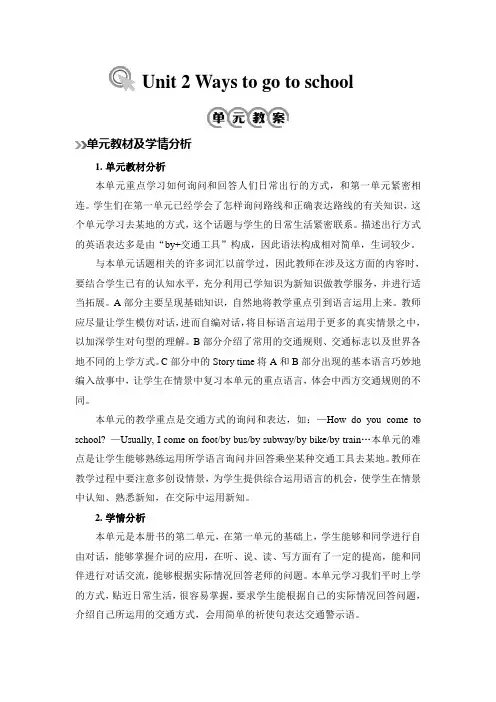
Unit 2 Ways to go to school单元教材及学情分析1.单元教材分析本单元重点学习如何询问和回答人们日常出行的方式,和第一单元紧密相连。
学生们在第一单元已经学会了怎样询问路线和正确表达路线的有关知识,这个单元学习去某地的方式,这个话题与学生的日常生活紧密联系。
描述出行方式的英语表达多是由“by+交通工具”构成,因此语法构成相对简单,生词较少。
与本单元话题相关的许多词汇以前学过,因此教师在涉及这方面的内容时,要结合学生已有的认知水平,充分利用已学知识为新知识做教学服务,并进行适当拓展。
A部分主要呈现基础知识,自然地将教学重点引到语言运用上来。
教师应尽量让学生模仿对话,进而自编对话,将目标语言运用于更多的真实情景之中,以加深学生对句型的理解。
B部分介绍了常用的交通规则、交通标志以及世界各地不同的上学方式。
C部分中的Story time将A和B部分出现的基本语言巧妙地编入故事中,让学生在情景中复习本单元的重点语言,体会中西方交通规则的不同。
本单元的教学重点是交通方式的询问和表达,如:—How do you come to school? —Usually, I come on foot/by bus/by subway/by bike/by train…本单元的难点是让学生能够熟练运用所学语言询问并回答乘坐某种交通工具去某地。
教师在教学过程中要注意多创设情景,为学生提供综合运用语言的机会,使学生在情景中认知、熟悉新知,在交际中运用新知。
2.学情分析本单元是本册书的第二单元,在第一单元的基础上,学生能够和同学进行自由对话,能够掌握介词的应用,在听、说、读、写方面有了一定的提高,能和同伴进行对话交流,能够根据实际情况回答老师的问题。
本单元学习我们平时上学的方式,贴近日常生活,很容易掌握,要求学生能根据自己的实际情况回答问题,介绍自己所运用的交通方式,会用简单的祈使句表达交通警示语。
单元教学目标1.知识目标(1)能够掌握A和B部分Let's talk,Let's learn中的四会短语和句子。
人教版英语必修五Unit 2(Puzzles in Geography)表格教学设计
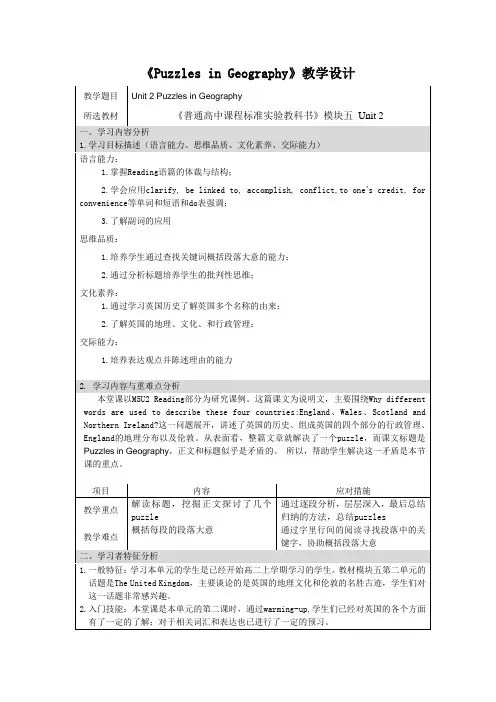
《Puzzles in Geography》教学设计Northern Ireland, England and Scotland have different educational and legal systems as well as different football teams for competitions like the World Cup!教师提问:1. Do the four countries work together?(To their credit the four countries do work together in some areas)(教师追问:what does “to their credit” mean? Why did the author use “do” before “work”)2. Do they work together in all areas?(but they still have very different institutions)(教师追问:what did the author put emphasis on? How do you know?)设计意图:把这一段呈现在ppt上,一方面是为了直观的展示这一段要表达的两个意思(四个国家在某方面相互合作,但也有各自的机构)中,作者通过but一词强调后者;另一方面是为了突出’to their credit’和’do work”这两个短语,学习它们的意思和用法。
Para 4: England本段主要引导学生探讨Why is England mentioned? 对于这个问题,学生很容易找到的原因是本段中的England is the largest of the four。
其实,关于这个问题,还有两个隐含的原因。
教师可引导学生回忆英国历史,通过回忆,他们就不难发现第二个原因England was the first of the four。
人教版英语九年级全册Unit2单元教学设计
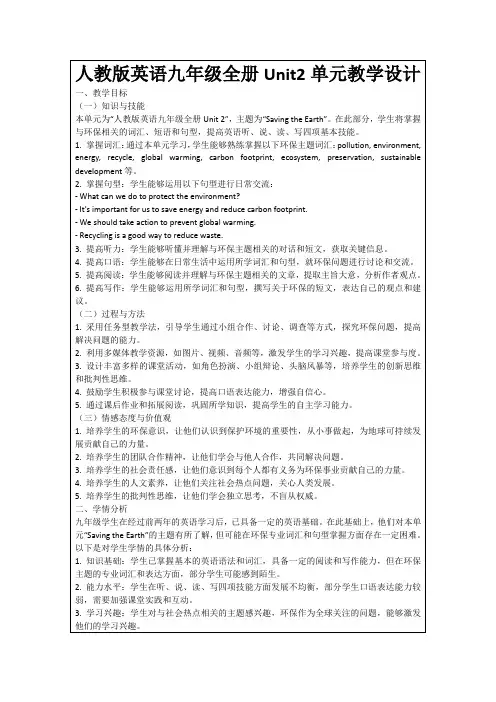
(二)过程与方法
1.采用任务型教学法,引导学生通过小组合作、讨论、调查等方式,探究环保问题,提高解决问题的能力。
2.利用多媒体课堂参与度。
3.设计丰富多样的课堂活动,如角色扮演、小组辩论、头脑风暴等,培养学生的创新思维和批判性思维。
-口语交流中,如何流畅使用所学句型和词汇,进行有深度的对话。
(二)教学设想
1.教学策略:
-采用情景教学法,通过图片、视频等直观教具,让学生在真实语境中感知和学习环保词汇和句型。
-利用任务驱动法,设计小组合作任务,让学生在完成具体任务的过程中,自然习得语言知识。
-实施差异化教学,针对不同学生的学习需求和能力水平,提供个性化的学习材料和指导。
3.强调环保的重要性,激发学生课后参与环保活动的热情。
4.布置课后作业,要求学生运用所学知识完成相关练习,为下一节课的学习做好准备。
五、作业布置
为了巩固本单元的学习成果,培养学生的自主学习能力,特布置以下作业:
1.词汇练习:要求学生复习本单元所学的环保主题词汇,并运用这些词汇完成课后练习册的相关练习。此外,鼓励学生通过查阅词典、网络资源等,自主扩展更多环保词汇,为课堂讨论和写作积累素材。
-组织学生进行环保主题的研究性学习,提高学生的探究能力和批判性思维能力。
四、教学内容与过程
(一)导入新课
在导入环节,我将采用以下方法激发学生的兴趣和好奇心,为学习新课做好准备:
1.展示地球生态环境的图片,让学生观察并思考:“What do you see in these pictures? How do you feel about them?”通过这种方式,让学生意识到环保问题的紧迫性。
Unit2 单元整体教学设计-小学英语五年级上册(人教PEP版)
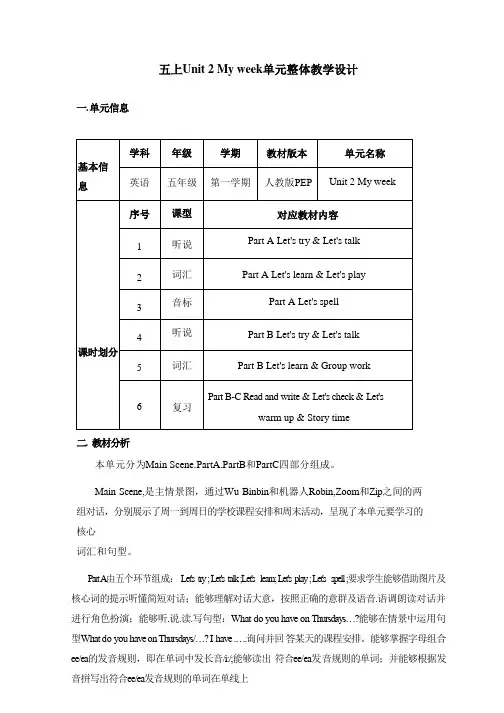
五上Unit 2 My week单元整体教学设计一. 单元信息二. 教材分析本单元分为Main Scene.PartA.PartB和PartC四部分组成。
Main Scene,是主情景图,通过Wu Binbin和机器人Robin,Zoom和Zip之间的两组对话,分别展示了周一到周日的学校课程安排和周末活动,呈现了本单元要学习的核心词汇和句型。
Pa rt A由五个环节组成: Let's try ; Let's talk ;Let's learn; Let's play ; Let's spell ;要求学生能够借助图片及核心词的提示听懂简短对话;能够理解对话大意,按照正确的意群及语音.语调朗读对话并进行角色扮演;能够听.说.读.写句型:What do you have on Thursdays…?能够在情景中运用句型What do you have on Thursdays/…? I have .….询问并回答某天的课程安排。
能够掌握字母组合ee/ea的发音规则,即在单词中发长音/i:/;能够读出符合ee/ea发音规则的单词;并能够根据发音拼写出符合ee/ea发音规则的单词在单线上完成抄写句子的活动,做到书写规范。
Part B由七个环节组成:Let's try;Let's talk;Let's learn;Group work;Read and write; Let's check;Let's wrap it up.要求学生能够在情景中运用核心词组和句型Do you often read books…?Y es.I do./ No,I don't.询问并回答经常从事的周末活动;能够按照正确的意群及语音.语调朗读Robin的建议,理解建议内容并仿写句子补全对话,做到书写规范。
能够读懂关于主线人物周末活动的三个句子.并描述自己的周末活动;能够在图片的帮助下读懂Wu Binbin和机器人的对话,完成判断信息正误的活动;能够根据提供的信息模仿对话,补全新的对话。
新译林版英语六年级上册Unit 2(表格版)1教案(推荐)
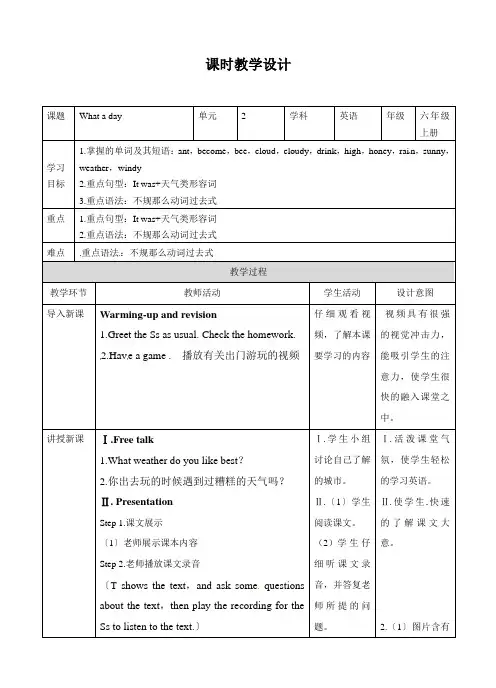
课时教学设计课题What a day 单元 2 学科英语年级六年级上册学习目标1.掌握的单词及其短语:ant,become,bee,cloud,cloudy,drink,high,honey,rai n,sunny,weather,windy2.重点句型:It was+天气类形容词3.重点语法:不规那么动词过去式重点 1.重点句型:It was+天气类形容词2.重点语法:不规那么动词过去式难点.重点语法:不规那么动词过去式教学过程教学环节教师活动学生活动设计意图导入新课Warming-up and revision1.Greet the Ss as usual. Check the homework.2.Hav e a game . 播放有关出门游玩的视频仔细观看视频,了解本课要学习的内容视频具有很强的视觉冲击力,能吸引学生的注意力,使学生很快的融入课堂之中。
讲授新课Ⅰ.Free talk1.What weather do you like best?2.你出去玩的时候遇到过糟糕的天气吗?Ⅱ. PresentationStep 1.课文展示〔1〕老师展示课本内容Step 2.老师播放课文录音〔T shows the text,and ask some questionsabout the text,then play the recording for theSs to listen to the text.〕Ⅰ.学生小组讨论自己了解的城市。
Ⅱ.〔1〕学生阅读课文。
(2)学生仔细听课文录音,并答复老师所提的问题。
Ⅰ.活泼课堂气氛,使学生轻松的学习英语。
Ⅱ.使学生快速的了解课文大意。
2.〔1〕图片含有become →becamebring →broughtcan →couldfly →flewgo →wentsee →sawtake →tookStep 2 课堂练习用括号所给的词的正确形式填空。
〔1〕It_____sunny yesterday.〔be〕〔2〕He_____to the park last night.〔go〕〔3〕I_____man y parrots in the park in this morning.〔see〕〔4〕He_____play the piano at the age of five.〔can〕〔5〕There______many ants on the ground in this afternoon.〔be〕Step 3 英语日记的写法〔1〕星期和日期写在左上角,顺序是星期,月份,年。
人教精通版四年级上册英语 unit 2单元教学设计表格式教案
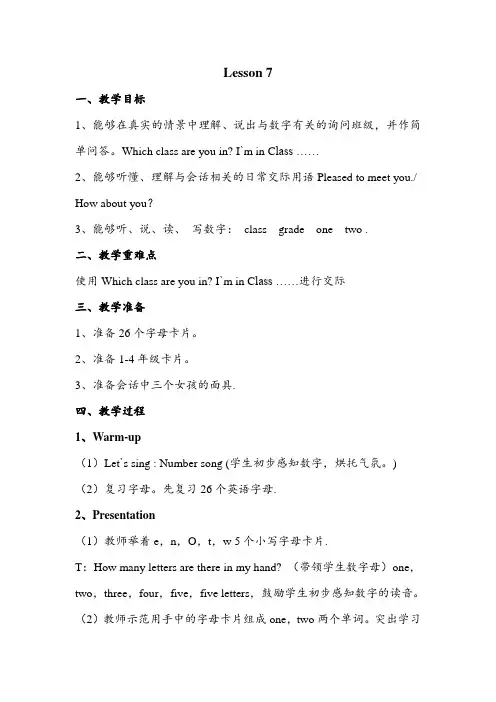
Lesson 7一、教学目标1、能够在真实的情景中理解、说出与数字有关的询问班级,并作简单问答。
Which class are you in? I`m in C lass ……2、能够听懂、理解与会话相关的日常交际用语Pleased to meet you./ How about you?3、能够听、说、读、写数字:class grade one two .二、教学重难点使用Which class are you in? I`m in C lass ……进行交际三、教学准备1、准备26个字母卡片。
2、准备1-4年级卡片。
3、准备会话中三个女孩的面具.四、教学过程1、Warm-up(1)Let`s sing : Number song (学生初步感知数字,烘托气氛。
) (2)复习字母。
先复习26个英语字母.2、Presentation(1)教师举着e,n,O,t,w 5个小写字母卡片.T:How many letters are there in my hand? (带领学生数字母)one,two,three,four,five,five letters,鼓励学生初步感知数字的读音。
(2)教师示范用手中的字母卡片组成one,two两个单词。
突出学习单词的趣味性,让学生明白字母可以组成单词。
(3)教师板书,示范书写单词。
指导学生掌握正确的书写习惯,帮助学生打下良好的书写基础。
(4)教师出示一所学校的场景。
向学生介绍每个教室是几年级几班,教师依次引导学生开口说,Class…,Grade…特别注意让学生观察年级和班级在汉语和英语表达中的区别,先让学生试着说,然后教师总结。
英语表达地点或范围的顺序是由小到大,汉语则相反。
(5) T:A:Which class are you in? S:I'm in C lass…(在真实的情景中运用语言。
)(6) 教师向学生出示图片,介绍Li Yan,Sue,Kate及她们之间的关系,让学生看图,试着说出会话内容。
新目标人教版九年级英语Unit2教学设计
新目标人教版九年级英语Unit2教学设计2013-2014 XXX High School English Electronic Lesson Plan Design TableUnit XXX: I Used to Be Afraid of the DarkSchool: N/An Item Value: 5 pointsn Standard: n een Curriculum Standards and Textbook UnitsXXX for students in the high school entrance n。
in order to better XXX practice。
through textbook analysis。
XXX' knowledge and language abilities。
XXX.Language Skills:1.Listening: Students can understand the structure of "used to do" and the content to be expressed。
and can extract n from the dialogue。
they can record and mark n based on the content of the "what you used to be like" XXX.2.Speaking: Students XXX' appearance。
personality。
interests。
and hobbies。
and express their own ns。
they can perform role-playing activities according to the topic。
in oral activities。
Unit2Bodylanguage大单元整体教学设计牛津深圳版(广州沈阳通用)八年级英语下册
单元整体教学设计表二:单元大观念:主题大观念小观念1:了解肢体语言及其在日常交际中的重要作用小观念2: 了解肢体语言在不同文化背景下的不同含义小观念3:根据已经设定的情境,撰写提醒式便条单元大观念:引导学生了解相同或相近肢体语言在不同文化交际中的含义,关注文化的异同,在日常交际中注意并理解他人输出:撰写一份报告陈述肢体语言在日常交际中的重要性、简单比较中西方对于同一肢体语言的不同含义。
输出:将自己的肢体语言与某位同学的肢体语言进行比较,就肢体语言的使用提出建议。
输出:写一篇演讲稿并演讲,介绍眼神交流在不同国家和地区含义上的区别。
输出:根据已设定的情境,独立撰写一份便条。
Reading:阅读一则发生在旅行社中的有关不同肢体语言给顾客留下不同印象的故事;Grammar:介绍动名词的基本概念和构成以及动名词作主语和宾语的用法。
Speaking:讨论常见姿势的含义Culture corner:了解世界各国不同的问候方式。
More practice:了解眼神交流在不同文化背景下的不同含义。
Listening:了解舞者的肢体语言—芭蕾舞。
Writing:了解便条的基本格式,并撰写一则提醒朋友准时赴约共赏芭蕾舞的便条。
核心素养的综合表现:学生能够运用所学目标语言介绍不同的肢体语言以及其意义;并能评价他人及自己行为举止中得体或需要改进的地方,同时能提出改善的建议。
学情分析(一)自然情况本单元围绕“肢体语言”这一话题,以“肢体语言”的含义及其在日常交际中的重要作用为主线,开展教学活动,了解肢体语言。
符合Module 1 Social munication 这个话题的内容探究,以及八年级学生对知识的汲取需求。
(二)已有基础语言大观念小观念1:围绕语义整合性学习词汇和表达方式小观念2:围绕本单元所学目标语言点,写一封感谢信,感谢寄宿家庭提供的帮助。
肢体语言对于日常交际的影响描述方式语篇结构 了解不同的肢体语言Body language, lady, munication,meaning, gesture, bored, sit up, take place, parttime, hold, welldressed, sigh, matter, later,appearance, remind, impression, towards, make a good impression onballet, neck, cross, nod, shake, sure, contact, eye contact, while, understanding, Asian, Westerner, lie, cause, either,especially, stranger, impolite1. 主题:This is to remind you about…2. 时间和地点:I’ll meet/wait for you + place + time.3. 注意事项: •Don’t forget to… •Remember to … experience…1. Start with a greeting. (e.g. Dear)2. Talk about the topic in the first sentence.3. Give the message clearly in a few words.4. End with a friendly word or phrase. (e.g. Best wishes)。
Module4HomealoneUnit2大单元教学设计(表格式)外研版英语九年级上册
2.Reading & thinking 词汇:manage,order,midnight,empty,unable,burn,snack,tun off, be worried about,on business, wake up,句型:although, so...that1.获取独自居家的细节信息;2.从正反两方面来论述独自居家的注意事项,并给予归纳性的总结;nguage in use so…that 引导的结果状语从句,though引导的让步状语从句头脑风暴环节能够造句,并能在模块写作任务中,合理运用4.Promotio n & assessment 动词短语:keep doors locked, go overlessons, wash dishes, do somereading... 描述心情形容词:worried,sad... so…that, though,介绍独自居家指南图表2:单元主题内容框架图表3:单元主题大、小观念建构流程图表4:单元主题大观念建构流程图表5:单元语言大观念建构流程学情分析(Analysis of the students) 教师在课前设计并发布了与本课学习内容的问卷星调查问卷。
(一)已有基础1. 本课授课对象为九年级学生,大部分学生已经具备较好的英语基础。
学生具备一定的阅读策略以及交流合作能力。
2. 学生在七上学习过跟饮食、学习有关的话题文章,在八上也学过与安全有关的话题文章,也都有过独自居家的经历,对于独自居家话题并不陌生,并且有自己粗略的认知。
3. 学生在七八年级的拓展学习中,对于so...that引导的结果状语从句和although引导的让步状语从句有所感知和理解。
(二)存在问题1. 学生的对于独自居家的注意事项缺乏系统而深入的思考、完成分析性问题能力有待提升。
2. 通过问卷调查发现,大部分学生对于独自居家,仍然感到焦虑、孤独,对于是否能够很好地自我管理,依旧心存担忧、缺乏把握。
译林版英语九年级上册第二单元教案 表格型
(3)Fill in the blanks:
Hobo brings Eddie some clothes, one is _____, another is ______. Eddie ______ ______ wear ____ than ______ because he thinks _____ is a girl’s colour. Hobo says there is ________ wrong ______ pink and helps Eddie put on the blue one. Eddie feels embarrassed (尴尬的) but Hobo says blue _____ good ___ him.
3. Some people prefer this colour when they hope for success.
4. If you require strength in either body or mind, red may be of some help to you.
5. Wearing red can also make it easier to take action.
Step 5: Homework
(1) Recite the comic strip.
(2) Finish the exercises on the workbook.
Blackboard design:
Unit 2 Colours
Comic strip and welcome to the unit
(2)Talk about different colours we have learnt before and fill in the blanks with the names of colours
- 1、下载文档前请自行甄别文档内容的完整性,平台不提供额外的编辑、内容补充、找答案等附加服务。
- 2、"仅部分预览"的文档,不可在线预览部分如存在完整性等问题,可反馈申请退款(可完整预览的文档不适用该条件!)。
- 3、如文档侵犯您的权益,请联系客服反馈,我们会尽快为您处理(人工客服工作时间:9:00-18:30)。
Unit 2 How often do you do exercise 教学设计hardly ever … He never ...Step 3 . Work on 1a.1. Look at the picture. Discuss with your partners. Make a list of the weekend activities.2. Let some Ss read out their activities. Let other Ss add more activities. Step 4 . Work on 1b.1. Let a student read the words aloud. Make sure all the Ss know the meaning of the words.2. Tell Ss to listen and write the letters from the picture above on the line below.3. Play the tape for the first time. Ss listen and fill in the blanks.4. Play the tape for the second time for the Ss to check the answers.Step 5. Pair work.1. Act out the conversation with a student.2. Let Ss talk about the pictures in 1a in pairs.3. Let some Ss act out their conversations.Step 6 Learn the new language.Show the pictures and ask and answer: How often do you exercise?--Twice a week.Step 7. Work on 2a:1. Let Ss read the phrases in the chart.2. Tell Ss that Cheng Tao is taking about how often he does theseactivities. Play the recording for the first time. Ss listen and number the activities [1-5].3. Play the recording for the second time for the Ss to check the answers. Step 8.Work on 2b:1. Tell Ss they will hear the recording again. This time, listen and matchthe activities in 2a with how often Cheng Tao does them.2. Ss listen and math the activities with the phrases.3. Check the answers.Step 9. Pair work.1. Ask one student how often he/she watch TV as a model.T: Hi, S1. How often do you watch TV? S1: I watch TV every day.T: What’s your favorite program? S1: Animal world.T: How often do you watch it? S1: Twice a week.2. Let one student read the activities in the chart. Tell them these new words:favorite website (最喜欢的网站);favorite sport (最喜欢的运动)3. Ss work with their partners. Then ask some pairs to act out their conversations.Step 10. Writing.According to the conversation, write about how often your partner do the activities.Example: ×× is a Middle School student. He reads English twice a week.课后反思:_________________________________________________________________________________ _________________________________________________________________________________ _________________________________________________________________________________ _________________________________________________________________________________教学方法任务型教学、模仿示范法、情景教学和合作学习法学习方法课前预习、课堂内外练习、听说读写结合主案副案教学过程Step 1 Review:1.Show a subject schedule, ask and answer:How often do you have _________ class? --We have _________class ____________.Step 2 Work on 2d.1. Lead in: Show some pictures and practice:A: What does she usually do? --B: She usually has piano lessons.A: How often does she have piano lessons? --B: She has piano lessons twice a week.2. show a video, and ask : What dance? –swing dance.Claire are having dance and piano lessons. Let’s listen to her and Jack’s conversation, listen and answer:3. Read the conversation and match the activity with the right time.4. Follow the tape and then Role-play the conversation.Step 3 Grammar focus:1. Practice: show the pictures and the pie charts, ask and answer:T: How often does he play soccer ? The other Ss: He plays soccer twice a week2. read grammar focus and give some explanations.Step 4 Work on 3a.Complete the questions with do or does. Then match the questions and answers.Step 5 Work on 3b.1. Tell Ss to make questions.2. Then try to ask and answer questions about the questions.3. Ask some Ss to ask and answer with their partners in front of the class.Step 6 Work on 3c.1. Let Ss work in groups of six or e ight.2. Tell Ss discuss what activities they do to improve their English. Thenwrite the activities in the chart.3. Ask their group mates the questions and fill in the chart.4. Try to make a report about their partners.家庭作业1. 听教材会话录音并进行模仿朗读。
2. 询问自己的3位朋友,完成3c的表格,并写一份报告。
.课后反思:_________________________________________________________________________________ _________________________________________________________________________________ _________________________________________________________________________________ _________________________________________________________________________________课后反思:_________________________________________________________________________________ _________________________________________________________________________________ _________________________________________________________________________________ _________________________________________________________________________________方法学习方法课前预习、课堂内外练习、听说读写结合主案副案教学过程Step 1 . Warming- up and revision1. Daily greeting.2. Let some Ss report what he/she does on weekends.Step 2 Work on 2a.1. Let Ss discuss the activities with their classmates and rank theseactivities according to how often you think your classmates do them.2. Let some Ss tell their answers.S tep 3 . Work on 2b.1. T: Here are the results of what the students in No. 5 High School do intheir free time. Read the passage quickly and find the answers to the two questions:1) How many kinds of free time activities are mentioned in the passage?2) What is the best way to relax? _________________________________2. Read the passage carefully and complete the pie chart below.Ss read the passage and try to fill in the pie chart. Then check the answers together.Step 4 Work on 2c.1. T: Now let’s read through the fi ve questions. Make sure the Ss know themeaning of the questions. Then le t Ss read the passage again and try to find the answers to the questions.2. Ss read carefully and try to find the answers to the questions.3. Check the answers with th e class.Step 5 Work on 2d.1. T: Now let’s make some sentences with the percentages using always,usually or sometimes.2. Ss read the passage again and try to make some new sentences. Checkthe answers with each others.Step 6 Work on 2e.1. Let Ss read through the activities in the chart first. Select one activityfrom them. Then ask their classmates how often they do this activity and make a pie chart.2. Ss work in groups. Ask and answer questions then fill in the chart.3. Make a pie chart like those in 2b.4. Then try to make a short report like the report in 2b.Step 7. HomeworkExercise book.家庭作业Read their own travel diaries again and find out mistakes.板书设计Unit 2 How often do you exercise?exerciseActivities use of the Internet the best way to relax is to rlax watching TV课后反思:_________________________________________________________________________________ _________________________________________________________________________________ _________________________________________________________________________________ _________________________________________________________________________________课题Period Five: Self check and Revision( 3a-self check)教学目标1. Knowledge aims:Key words and phrases: watch TV for over 2 hours, stay up late, go to the dentist, almost2. Ability aims: Writing skills of h ow to write a composition of one’s habits.3. Emotional aims: Tell students about good habits重点难点1. Learn the above expressions:2. Learn to writ e one’s own habits.教学方法任务型教学、模仿示范法、情景教学和合作学习法学习方法课前预习、课堂内外练习、听说读写结合主案副案教学过程Step 1 . Warming- up and revision.1. Have a dictation of the new words and expressions.2. Let some Ss read the passage in 2b.3. Check the homework.Step 2 . Presentation.1. Show some pictures of your daily activities. Tell Ss your good activitiesand bad activities.2. Let some Ss tell about how often they do some activities and judgethey are good habits and bad habits.Step 3. Practice –work on 3a.1. Look at the information in the chart and complete the report.2. Ss read the passage then fill in the blanks with the words in the box.3. . Check the answers.Step 4. Writing--work on 3b.1. Complete the chart with your own information. Then in the lastcolumn, use expressions like always, every day, twice a week and never.2. Then let some Ss show their chart to the class.Step 5 Work on 3c.1. Let Ss write a report about their good habits and bad habits. Say howoften they do things using the report in 3a as an example.2. Students write.3. Check the compositions and let some Ss read their compositions.Step 6 Self Check 1 and 2.1. Students discuss.2. Let some Ss read aloud their chart. Then try to write five sentencesusing the information above.3. Make sure they use the correct forms of the verbs.Step 7 Self check 3.1. Tell Ss that they should read the conversation and then fill in the blankswith the right forms.2. Ss read the conversations and try to fill in the blanks.3. Check the answers:usually, How often, Hardly, How often, once a; never4. Let Ss practice the conversation with their partner.家庭作业1. Review Section B.2. Write a short passage your father or m other’s good habits or bad habits.板书设计1. how often 2. as for 3. junk food 4.eating habit 5.of course6.look after7. start with8. Not….at all9. go shopping10.have a party 11. go to the movie 12. once a week 13. hardly ever14. twice a week 15. three times a week16. more than17.such as18. do homework19. a lot of20. be good for21. help sb (to) do sth.22. go to the dentist23.keep in good health课后反思:_________________________________________________________________________________ _________________________________________________________________________________ _________________________________________________________________________________。
